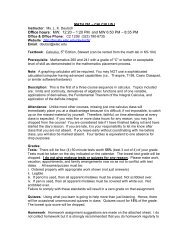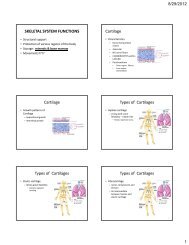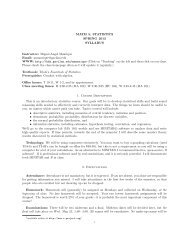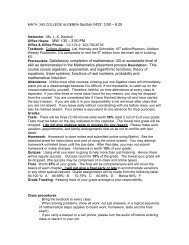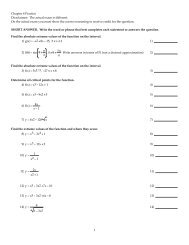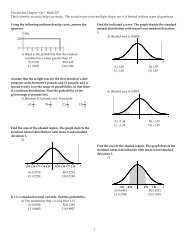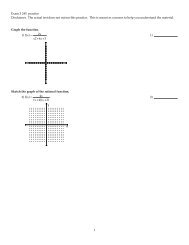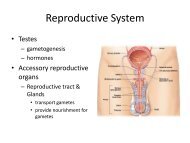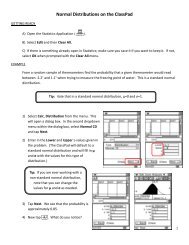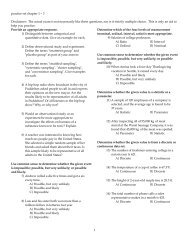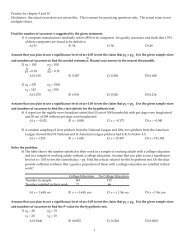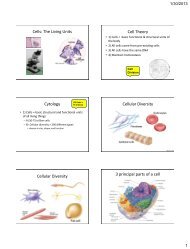Immunology - Trifecta
Immunology - Trifecta
Immunology - Trifecta
Create successful ePaper yourself
Turn your PDF publications into a flip-book with our unique Google optimized e-Paper software.
Immune System<br />
• Functional system rather than organ system<br />
– Removes pathogenic cells, infected cells, or<br />
abnormal cells<br />
• Immunity = ability to ward off microorganisms<br />
• divisions<br />
– Innate (non-specific) immunity<br />
• Response: fast, non-specific<br />
– Adaptive (acquired) immunity<br />
• Response: slow, specific
Innate immunity<br />
• 1 st line of defense:<br />
barriers<br />
• 2 nd line of defense: Cells<br />
and chemicals<br />
– Recognizes and destroys<br />
– Response does NOT<br />
change<br />
– Inflammation<br />
• Primary response of the<br />
innate system<br />
• Inhibits the spreading of<br />
pathogens
physical and<br />
chemical barriers<br />
• Cutaneous secretion<br />
– Sweat<br />
– Sebum<br />
• Mucosal secretion<br />
– Acidic secretion (gastric<br />
and vaginal)<br />
– Mucus<br />
• Mucociliary escalator
physical and<br />
chemical barriers<br />
• Body Fluids: Tears,<br />
saliva, and urine<br />
– wash away<br />
microorganisms<br />
– Lysozyme<br />
• Normal flora vs.<br />
pathogenic<br />
microorganisms
Internal Defenses
Phagocytes<br />
• Neutrophils & Macrophages<br />
• Events of phagocytosis<br />
– Phagocyte adheres to<br />
pathogens<br />
• opsonins<br />
– Phagosome<br />
– phagolysosome<br />
– digestion<br />
– Exocytosis of vesicle<br />
• removes indigestible and<br />
residual material
opsonization
Natural Killer Cells<br />
• Non-phagocytic lymphocytes<br />
– No memory<br />
• Response: rapid<br />
– apoptosis in cancer and virusinfected<br />
cells<br />
• Perforin<br />
• granzymes<br />
• INF-alpha & beta<br />
– Anti-viral replication<br />
– Activates NK<br />
• INF-gamma<br />
– Activates macrophage & NK
• Secreted by lymphocytes<br />
• INF-alpha & beta<br />
– Anti-viral replication<br />
Interferons (INF)<br />
• block viral reproduction<br />
and degrade viral RNA<br />
– Activates NK lymphocytes<br />
• INF-gamma (immune<br />
INF)<br />
– Activates macrophage &<br />
NK lymphocytes
complement proteins<br />
• 20-25 blood proteins<br />
– inactive form<br />
• Complement cascade<br />
– Complement activation<br />
• Result<br />
– Lysis
Complement System<br />
• Compliment activated<br />
– By direct interaction<br />
with a pathogen or by<br />
antibodies<br />
• Activated complements<br />
results in<br />
– Chemotaxis<br />
– Opsonization<br />
– Inflammation<br />
– Lysis<br />
• Basophils & mast cells<br />
© 2013 Pearson Education, Inc.
Inflammation<br />
• occurs whenever tissues are damaged<br />
• Objectives<br />
– Chemotaxis to prevents the spread of infection<br />
– Disposes of pathogens & debris<br />
– promote tissue repair once the infection is under<br />
control
signs of acute inflammation<br />
• damaged tissues releasing<br />
– histamine, prostaglandins, kinins, leukotrienes<br />
– Heat & Redness<br />
• local vasodilation: blood flow to the area (local<br />
hyperemia)<br />
– Swelling<br />
• local capillary permeability: edema<br />
– dilution of harmful substances<br />
– delivery of clotting factors, oxygen, & nutrients for tissue<br />
repair<br />
– Diapedesis => chemotaxis<br />
– Pain => Impairment of function<br />
• Bradykinin: stimulate pain-sensitive neurons
Innate defenses<br />
Internal defenses<br />
Inflammation: flowchart of events.<br />
Tissue injury<br />
Initial stimulus<br />
Physiological response<br />
Signs of inflammation<br />
Result<br />
Release of inflammatory chemicals<br />
(histamine, complement,<br />
kinins, prostaglandins)<br />
Release of leukocytosisinducing<br />
factor<br />
Leukocytosis<br />
(increased numbers of white<br />
blood cells in bloodstream)<br />
Arterioles<br />
dilate<br />
Increased capillary<br />
permeability<br />
Attract neutrophils,<br />
monocytes, and<br />
lymphocytes to<br />
area (chemotaxis)<br />
Leukocytes migrate to<br />
injured area<br />
Local hyperemia<br />
(increased blood<br />
flow to area)<br />
Capillaries<br />
leak fluid<br />
(exudate formation)<br />
Margination<br />
(leukocytes cling to<br />
capillary walls)<br />
Heat<br />
Redness<br />
Leaked protein-rich<br />
fluid in tissue spaces<br />
Pain<br />
Swelling<br />
Leaked clotting<br />
proteins form interstitial<br />
clots that wall off area<br />
to prevent injury to<br />
surrounding tissue<br />
Diapedesis<br />
(leukocytes pass through<br />
capillary walls)<br />
Phagocytosis of pathogens<br />
and dead tissue cells<br />
(by neutrophils, short-term;<br />
by macrophages, long-term)<br />
Locally increased<br />
temperature increases<br />
metabolic rate of cells<br />
Possible temporary<br />
impairment of<br />
function<br />
Temporary fibrin<br />
patch forms<br />
scaffolding for repair<br />
Pus may form<br />
Area cleared of debris<br />
Healing<br />
© 2013 Pearson Education, Inc.
Innate defenses<br />
Internal defenses<br />
Slide 1<br />
Chemotaxis<br />
Inflammatory<br />
chemicals<br />
diffusing<br />
from the<br />
inflamed<br />
site act as<br />
chemotactic<br />
agents.<br />
4<br />
Chemotaxis<br />
Capillary wall<br />
Basement<br />
membrane<br />
Endothelium<br />
1 Leukocytosis. 2 Margination. 3<br />
Neutrophils enter<br />
blood from bone<br />
marrow.<br />
Neutrophils cling<br />
to capillary wall.<br />
Diapedesis.<br />
Neutrophils emigration
Fever<br />
• Systemic response to infection<br />
– Leukocytes and macrophages: pyrogens<br />
• When is it good? Mild fever<br />
– liver and spleen: sequester iron and zinc (needed<br />
by microorganisms)<br />
– metabolic rate => faster repair<br />
• When is it bad? High fever<br />
– Hallucinations, Confusion, Irritability, Convulsions,<br />
Dehydration
Adaptive (acquired) immunity<br />
• 3 rd line of defense<br />
– Specific and improves<br />
efficiency each time it<br />
encounters the same<br />
pathogen<br />
• Divisions<br />
• Slow onset on initial<br />
exposure<br />
• Quick response on 2 nd<br />
exposure – memory cells<br />
– Cell-mediated immunity<br />
– humoral immunity
Lymphocytes<br />
• 2 main classes ______<br />
• Development<br />
• Maturation<br />
– Immunocompetency<br />
• lymphocyte can recognize one specific<br />
antigen<br />
• Clone = group of lymphocytes<br />
• Clonal expansion => Naïve cells<br />
• Clonal deletion => no autoimmune dz<br />
– Self-tolerance: Lymphocytes<br />
unresponsive to self-antigens<br />
• Lymphocyte Activation<br />
– Antigen challenge: naive cells =><br />
activated cells
Adaptive defenses<br />
Figure 21.8 Lymphocyte development, maturation, and activation.<br />
Humoral immunity<br />
Cellular immunity<br />
Primary lymphoid organs<br />
(red bone marrow and thymus)<br />
Secondary lymphoid organs<br />
(lymph nodes, spleen, etc.)<br />
Slide 1<br />
Red bone marrow<br />
Lymphocyte<br />
precursors<br />
1 Origin<br />
• Both B and T lymphocyte precursors originate in red<br />
bone marrow.<br />
Thymus<br />
Red bone marrow<br />
2 Maturation<br />
• Lymphocyte precursors destined to become T cells migrate<br />
(in blood) to the thymus and mature there.<br />
• B cells mature in the bone marrow.<br />
• During maturation lymphocytes develop immunocompetence<br />
and self-tolerance.<br />
Antigen<br />
3 Seeding secondary lymphoid organs and circulation<br />
• Immunocompetent but still naive lymphocytes leave the<br />
thymus and bone marrow.<br />
• They “seed” the secondary lymphoid organs and circulate<br />
through blood and lymph.<br />
Lymph node<br />
4 Antigen encounter and activation<br />
• When a lymphocyte’s antigen receptors bind its antigen, that<br />
lymphocyte can be activated.<br />
© 2013 Pearson Education, Inc.<br />
5 Proliferation and differentiation<br />
• Activated lymphocytes proliferate (multiply) and then<br />
differentiate into effector cells and memory cells.<br />
• Memory cells and effector T cells circulate continuously in<br />
the blood and lymph and throughout the secondary<br />
lymphoid organs.
• Small groups of identical<br />
lymphocytes<br />
Clones<br />
• Each clone has many copies<br />
of the SAME RECEPTOR to a<br />
specific ANTIGEN<br />
– Antigen: foreign molecules<br />
provoking acquired immune<br />
response<br />
• > 1 million different varieties<br />
of clones<br />
– Result: Diverse lymphocytic<br />
responses
antigen-presenting cells (APCs)<br />
• Dendritic cells, macrophages, and activated B-<br />
cells<br />
– Do not respond to specific antigens<br />
– Objective: Present antigen fragments on the<br />
surface as a signal to Helper T-cells<br />
• “ID the invading antigens”
Acquired immunity<br />
• Humoral Immunity<br />
– Deals with extracellular antigens<br />
– B lymphocytes and plasma cells<br />
• cell-mediated immunity<br />
– deals with microorganisms inside the cells<br />
– Cytotoxic T-cells<br />
• Helper T Cells<br />
– Control‖ Adaptive Immunity<br />
• via regulating activites of B-cells & cytotoxic T-cells
MHC proteins<br />
• major histocompatibility complex proteins<br />
– AKA: Human Leukocyte Antigen (HLA)<br />
• International HLA system: ID compatibility in organ<br />
transplant<br />
– Glycoproteins found on cell surfaces<br />
– Coded by MHC genes (millions of different<br />
combinations)<br />
• 2 classes<br />
– MHC-I: found on all nucleated cells<br />
– MHC-II: found on APCs
APCs and MHC II Proteins<br />
• APC<br />
– Antigens displayed on<br />
class-II MHC protein<br />
• Costimulation<br />
– confirmation signal<br />
between APC & Helper<br />
T-cells<br />
• Clone formation<br />
– Activated Helper T-Cells<br />
• activate B cells and<br />
cytotoxic T cells
B-Cell Primary Response<br />
• APC<br />
– class-II MHC protein<br />
• Costimulation<br />
• Activated Helper T-Cells<br />
– activate B cells =><br />
plasma cells + memory<br />
cells
antibodies<br />
• AKA immunoglobulins<br />
or gamma globulins<br />
• Y-shaped structure<br />
– 4 polypeptide chains<br />
– variable regions<br />
– Constant region<br />
• binds to other immune<br />
cells and determines the<br />
mechanism the bound<br />
antigen will be destroyed<br />
• determine the antibody<br />
class
antibody class<br />
• IgM = associated with primary responses<br />
– Potent agglutinating agent<br />
• IgG = produced in secondary immune responses<br />
– Crosses placental barrier<br />
• IgA = in external secretions<br />
– prevent entry of pathogens<br />
• IgE = target parasites & associated with allergic<br />
responses<br />
• IgD = appear on the surface of B cells, role<br />
unclear (possibly as B cell receptor)
Antibody Action<br />
(PLAN)<br />
• Precipitation<br />
– Antibodies bind soluble<br />
antigens into clumps<br />
• Lysis<br />
– Antibodies bound to a<br />
bacterium activate<br />
complement<br />
• Agglutination<br />
– Antibodies bind cell<br />
surface antigens into<br />
clumps<br />
• Neutralization<br />
– antibodies bind to and<br />
mask the dangerous<br />
portions of antigens,<br />
toxins, and viruses
Figure 21.15 Mechanisms of antibody action.<br />
Adaptive defenses<br />
Humoral immunity<br />
Antigen<br />
Antigen-antibody<br />
complex<br />
Antibody<br />
Inactivates by<br />
Fixes and activates<br />
Neutralization<br />
(masks dangerous<br />
parts of bacterial<br />
exotoxins; viruses)<br />
Agglutination<br />
(cell-bound antigens)<br />
Precipitation<br />
(soluble antigens)<br />
Complement<br />
Enhances Enhances Leads to<br />
Phagocytosis Inflammation Cell lysis<br />
Chemotaxis<br />
Histamine<br />
release<br />
© 2013 Pearson Education, Inc.
Antigen-antibody complexes<br />
• do not destroy antigens<br />
• prepare them for destruction by innate defenses
B-Cell Response<br />
Primary Response<br />
• Lag period: longer<br />
– clonal selection<br />
– antibody production<br />
Secondary Response<br />
• Lag time: shorter<br />
– Plasma cells remain alive and<br />
functioning for a longer time
Adaptive defenses<br />
Humoral immunity<br />
Primary response<br />
(initial encounter<br />
with antigen)<br />
Activated B cells<br />
Proliferation to<br />
form a clone<br />
Antigen<br />
Antigen binding<br />
to a receptor on a<br />
specific B lymphocyte<br />
(B lymphocytes with<br />
noncomplementary<br />
receptors remain<br />
inactive)<br />
Plasma cells<br />
(effector B cells)<br />
Secreted<br />
antibody<br />
molecules<br />
Memory B cell—<br />
primed to respond<br />
to same antigen<br />
Secondary response<br />
(can be years later)<br />
Clone of cells<br />
identical to<br />
ancestral cells<br />
Subsequent<br />
challenge by same<br />
antigen results in<br />
more rapid response<br />
Plasma<br />
cells<br />
Secreted<br />
antibody<br />
© 2013 Pearson Education,<br />
molecules<br />
Inc.<br />
Memory<br />
B cells
Antibody titer (antibody concentration)<br />
in plasma (arbitrary units)<br />
Primary immune<br />
response to antigen<br />
A occurs after a delay.<br />
Secondary immune response to<br />
antigen A is faster and larger<br />
10 4<br />
10 3<br />
10 2<br />
10 1<br />
10 0<br />
Anti-<br />
Bodies<br />
to A<br />
Anti-<br />
Bodies<br />
to B<br />
0 7 14 21 28 35 42 49 56<br />
© 2013 Pearson Education, Inc.<br />
First exposure<br />
to antigen A<br />
Second exposure to antigen A;<br />
first exposure to antigen B<br />
Time (days)
B-Cell Immunity<br />
• Classified in 2 separate ways<br />
– Active immunity: memory cell produced in<br />
response to foreign antigen<br />
• Natural adaptive: infection<br />
• Artificial adaptive: vaccination<br />
– Passive immunity: antibodies from another<br />
person (animal) are transferred to a non-immune<br />
individual<br />
• Natural: IgG from mother to fetus or IgA from milk<br />
• Artificial: injection of serum (gamma globulin = antivenom)
Figure 21.13 Active and passive humoral immunity.<br />
Humoral<br />
immunity<br />
Active<br />
Passive<br />
Naturally<br />
acquired<br />
Infection;<br />
contact<br />
with<br />
pathogen<br />
Artificially<br />
acquired<br />
Vaccine;<br />
dead or<br />
attenuated<br />
pathogens<br />
Naturally<br />
acquired<br />
Antibodies<br />
passed from<br />
mother to<br />
fetus via<br />
placenta; or<br />
to infant in<br />
her milk<br />
Artificially<br />
acquired<br />
Injection of<br />
exogenous<br />
antibodies<br />
(gamma<br />
globulin)<br />
© 2013 Pearson Education, Inc.
Cell-Mediated Immunity<br />
• What is the big limitation of antibodies?<br />
• Cell-mediated immunity<br />
– deals with intracellular pathogens (& cancerous<br />
cells)<br />
– cytotoxic T-cells
Activating Killer T Lymphocytes<br />
• Infected host cell<br />
– MHC-I<br />
• Cytotoxic T-cells
T Lymphocyte Memory<br />
• How would the response of a memory Helper<br />
T cell or a memory cytotoxic T cell differ from<br />
the primary response?<br />
– Secondary Response:
Other T-cells<br />
• Suppressor T cells<br />
– suppress the activity of B cells and T cells<br />
– Prevent unnecessary immune activity<br />
• Regulatory T Lymphocytes<br />
– Prevents B & T-cells from going overboard
ABO Compatibility<br />
• RBC membranes<br />
– Lack MHC proteins<br />
– ABO blood group<br />
antigens<br />
• blood types: A, B, AB, and<br />
O<br />
– Rh antigens
Blood type Antigen on red blood cell Antibodies in plasma<br />
Blood type Antigen on red blood cell Antibodies in plasma<br />
O<br />
O<br />
RBC<br />
RBC<br />
No A or B antigens<br />
No A or B antigens<br />
“Anti-A” and “anti-B”<br />
“Anti-A” and “anti-B”<br />
A<br />
A<br />
A antigens<br />
A antigens<br />
“Anti-B”<br />
“Anti-B”<br />
FIGURE QUESTION<br />
FIGURE QUESTION<br />
Each person inherits one allele for ABO blood groups from<br />
each parent. A and B are dominant to O but equal if they<br />
occur together (blood type AB). Fill in the table showing<br />
combinations of inherited alleles. In the shaded blocks<br />
show the blood type that would be expressed.<br />
Each person inherits one allele for ABO blood groups from<br />
each parent. A and B are dominant to O but equal if they<br />
occur together (blood type AB).<br />
B<br />
B<br />
AB<br />
AB<br />
B antigens<br />
B antigens<br />
A and B antigens<br />
A and B antigens<br />
“Anti-A”<br />
“Anti-A”<br />
None to A or B<br />
None to A or B<br />
Father<br />
Father<br />
A<br />
B<br />
O<br />
A<br />
B<br />
O<br />
A<br />
A<br />
AA<br />
AA<br />
A<br />
A<br />
Mother<br />
Mother<br />
B<br />
B<br />
O<br />
O
• Ideal<br />
Organ Transplants<br />
– Autografts: from one body site to another in same<br />
person<br />
– Isografts: between identical twins<br />
• Most common<br />
– Allografts: between individuals who are not<br />
identical twins<br />
– ABO, other blood antigens, MHC antigens<br />
matched as closely as possible<br />
• Rare<br />
– Xenografts: from another animal species
Hypersensitivities<br />
• Immune responses to perceived (otherwise<br />
harmless) threat cause tissue damage<br />
• Different types distinguished by<br />
– Their time course<br />
– Whether antibodies or T cells involved<br />
• Antibodies cause immediate and subacute<br />
hypersensitivities<br />
• T cells cause delayed hypersensitivity<br />
© 2013 Pearson Education, Inc.
Subacute Hypersensitivities<br />
• Caused by IgM and IgG transferred via blood<br />
plasma or serum<br />
• Slow onset (1–3 hours) and long duration (10–<br />
15 hours)<br />
• Cytotoxic (type II) reactions<br />
– Antibodies bind to antigens on specific body cells,<br />
stimulate phagocytosis and complementmediated<br />
lysis of cellular antigens<br />
– Example: mismatched blood transfusion reaction<br />
© 2013 Pearson Education, Inc.
Subacute Hypersensitivities<br />
• Immune complex (type III) hypersensitivity<br />
– Antigens widely distributed in body or blood<br />
– Insoluble antigen-antibody complexes form<br />
– Complexes cannot be cleared from particular area<br />
of body<br />
– Intense inflammation, local cell lysis, and cell<br />
killing by neutrophils<br />
– Example: systemic lupus erythematosus (SLE)<br />
© 2013 Pearson Education, Inc.
Prevention of Rejection<br />
• After surgery<br />
– Patient treated with<br />
immunosuppressive therapy<br />
• Corticosteroid drugs to suppress<br />
inflammation<br />
• Antiproliferative drugs<br />
• Immunosuppressant drugs<br />
• Many of these have severe side<br />
effects<br />
© 2013 Pearson Education, Inc.
Severe Combined<br />
Immunodeficiency (SCID)<br />
Syndrome - Bubble Boy disease<br />
• Marked deficit in B and T cells<br />
• Fatal if untreated; treated with bone marrow<br />
transplants<br />
© 2013 Pearson Education, Inc.



